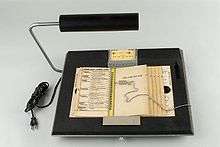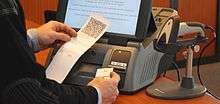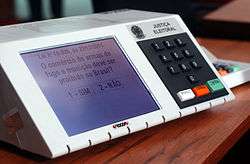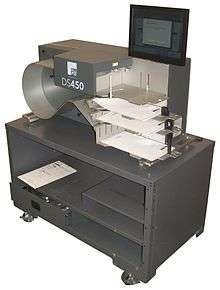Voting machine
| Election technology |
|---|
| Terminology |
|
| Testing |
| Technology |
| Manufacturers |
A Voting machine is a machine used to register and tabulate votes. The first voting machines were mechanical but it is increasingly more common to use electronic voting machines. Traditionally, a voting machine has been defined by the mechanism the system uses to cast votes and further categorized by the location where the system tabulates the votes.
Voting machines have different levels of usability, security, efficiency and accuracy. Certain systems may be more or less accessible to all voters, or not accessible to those voters with certain types of disabilities. They can also have an effect on the public's ability to oversee elections.
Early history
The first major proposal for the use of voting machines came from the Chartists in 1838.[1] Among the radical reforms called for in The People's Charter were universal suffrage and voting by secret ballot. This required major changes in the conduct of elections, and as responsible reformers, the Chartists not only demanded reforms but described how to accomplish them, publishing Schedule A, a description of how to run a polling place, and Schedule B, a description of a voting machine to be used in such a polling place.[2][3]
The Chartist voting machine, attributed to Benjamin Jolly of 19 York Street in Bath, allowed each voter to cast one vote in a single race. This matched the requirements of a British parliamentary election. Each voter was to cast his vote by dropping a brass ball into the appropriate hole in the top of the machine by the candidate's name. Each voter could only vote once because each voter was given just one brass ball. The ball advanced a clockwork counter for the corresponding candidate as it passed through the machine, and then fell out the front where it could be given to the next voter.
In 1875, Henry Spratt of Kent received a U.S. patent for a voting machine that presented the ballot as an array of push buttons, one per candidate.[4] Spratt's machine was typically British, allowing each voter to cast a fixed number of votes in a single race. In 1881, Anthony Beranek of Chicago patented the first voting machine appropriate for use in a general election in the United States.[5] Beranek's machine presented an array of push buttons to the voter, with one row per office on the ballot, and one column per party. Interlocks behind each row prevented voting for more than one candidate per race, and an interlock with the door of the voting booth reset the machine for the next voter as each voter left the booth.
Vote-recording technologies
Document-based ballot voting systems
A document ballot voting system records votes, counts votes, and produces a tabulation of the vote count from votes cast on paper cards or sheets. A document ballot voting system can allow for manual or electronic tabulation.
Manually marked and tabulated paper ballots
The first use of paper ballots to conduct an election appears to have been in Rome in 139 BCE, and the first use of paper ballots in the United States was in 1629 to select a pastor for the Salem Church.[6]
Punched card

Punched card systems employ a card (or cards) and a small clipboard-sized device for recording votes. Voters punch holes in the cards (with a supplied punch device) opposite their candidate or ballot issue choice. After voting, the voter may place the ballot in a ballot box, or the ballot may be fed into a computer vote tabulating device at the precinct.
The idea of voting by punching holes on paper or cards originated in the 1890s[7] and inventors continued to explore this in the years that followed.[8] The first major success for punched-card voting came in 1965, with Joseph P. Harris' development of the Votomatic punched-card system.[9][10][11] This was based on IBM's Port-A-Punch technology. Harris licensed the Votomatic to IBM.[12] William Rouverol built the prototype system.
The Votomatic system[13] was very successful. By the 1996 Presidential election, some variation of the punched card system was used by 37.3% of registered voters in the United States.[14]
Votomatic style systems and punched cards received considerable notoriety in 2000 when their uneven use in Florida was alleged to have affected the outcome of the U.S. presidential election.
Optical scan (marksense)
An optical scan, or marksense, voting system allows a voter to record votes by making marks directly on the ballot, usually in voting response locations.
Using electronic input device
A paper-based system may allow for the voter's selections to be indicated by marks made on a paper ballot by an electronic input device.
Voter-verified paper audit trail
Some traditionally non-document ballot voting systems may print a voter-verified paper audit trail (VVPAT) to serve as a document (ballot) for each vote.
Electronic ballot marker
An electronic ballot marker (EBM) or ballot marking device is categorized as any such input device that does not independently record, store, or tabulate the voter selections.
Non-document-based ballot voting systems
Direct-recording voting system

Commonly used in the United States until the 1990s (and commonly known as lever machines), direct recording voting systems are mechanical systems to tabulate votes. This was the first voting technology commercialized in the United States. In 1889, Jacob H. Myers of Rochester, New York received a patent for a voting machine that was based on Beranek's 1881 machine.[15] This machine saw its first use in Lockport, New York, in 1892.[16] In 1894, Sylvanus Davis added a straight-party lever and significantly simplified the interlocking mechanism used to enforce the vote-for-one rule in each race.[17] By 1899, Alfred Gillespie introduced several refinements. It was Gillespie who replaced the heavy metal voting booth with a curtain that was linked to the cast-vote lever, and Gillespie introduced the lever by each candidate name that was turned to point to that name in order to cast a vote for that candidate. Inside the machine, Gillespie worked out how to make the machine programmable so that it could support races in which voters were allowed to vote for, for example, 3 out of 5 candidates.[18]
On December 14, 1900, the U.S. Standard Voting Machine Company was formed, with Alfred Gillespie as one of its directors, to combine the companies that held the Myers, Davis, and Gillespie patents.[19] By the 1920s, this company (under various names) had a monopoly on voting machines, until, in 1936, Samuel and Ransom Shoup obtained a patent for a competing voting machine.[20] By 1934, about a sixth of all presidential ballots were being cast on mechanical voting machines, essentially all made by the same manufacturer.[21]
Commonly, a voter enters the machine and pulls a lever to close the curtain, thus unlocking the voting levers. The voter then makes his or her selection from a list of switches denoting the appropriate candidates or measures. The machine is configured to prevent overvotes by locking out other candidates when one candidate's switch is flipped. When the voter is finished, a lever is pulled which opens the curtain and increments the appropriate counters for each candidate and measure. The results are then hand written by the precinct officer at the conclusion of voting. New York was the last state to stop using these machines.[22][23]
Direct-recording electronic voting system
The successor to direct recording voting machines, a direct-recording electronic (DRE) voting system records votes by means of an electronic display provided with mechanical or electro-optical components that can be activated by the voter; that processes voter selections by means of a computer program; and that records that processed voting data in memory components. It produces a tabulation of the voting data that is stored in a removable memory component and may also provide printed renditions of the data. The system may further provide a means for transmitting the processed vote data to a central location in individual or accumulated forms for consolidating and reporting results from precincts at a central location. DRE systems additionally can produce a paper ballot printout that can be verified by the voter before they cast their ballot.
Public network direct-recording electronic voting system
A public network DRE voting system is an election system that uses electronic ballots and transmits vote data from the polling place to another location over a public network. Vote data may be transmitted as individual ballots as they are cast, periodically as batches of ballots throughout the election day, or as one batch at the close of voting.
 The Advanced Voting Solutions WINvote voting machine in Arlington County, Virginia.
The Advanced Voting Solutions WINvote voting machine in Arlington County, Virginia. A voting machine used in Bladensburg, Maryland 2004.
A voting machine used in Bladensburg, Maryland 2004. The TallyVoting Tally1 DRE in testing in Washington, DC.
The TallyVoting Tally1 DRE in testing in Washington, DC. Electronic voting machine by Smartmatic used in Belgian regional elections, 2014
Electronic voting machine by Smartmatic used in Belgian regional elections, 2014 A Brazilian voting machine
A Brazilian voting machine Voting machine to be used in Issy-les-Moulineaux during the 2007 French presidential election
Voting machine to be used in Issy-les-Moulineaux during the 2007 French presidential election ISG TopVoter, a voting machine specifically designed for disabled voters.
ISG TopVoter, a voting machine specifically designed for disabled voters. Similar to lever voting machines, the electromechanical Shouptronic voting machine.
Similar to lever voting machines, the electromechanical Shouptronic voting machine. A voting machine designed by Alfred J. Gillespie and marketed by the Standard Voting Machine Company of Rochester, New York from the late 1890s.
A voting machine designed by Alfred J. Gillespie and marketed by the Standard Voting Machine Company of Rochester, New York from the late 1890s. The famous lever of a lever voting machine still being used in 2008 in Kingston, New York
The famous lever of a lever voting machine still being used in 2008 in Kingston, New York Voting machine used for Indian general elections
Voting machine used for Indian general elections- Seven ticket voting machine, 1912.
Vote-tabulation technologies
Most voting systems (whether document ballot or non-document ballot) can be tabulated either at the place of voting or in another location. In this case "precinct" is the place of voting.
Precinct-count voting system
A precinct-count voting system is a voting system that tabulates ballots at the polling place. Generally, systems that hand count the ballots will tabulate only after the close of polling. Other voting systems typically tabulate the ballots as they are cast. In all systems, the vote totals are made public only after the close of polling. For DREs and some paper-based systems these systems provide electronic storage of the vote count and may transmit results to a central location over public telecommunication networks. This system allows for voters to be notified of voting errors such as over voting and can prevent residual votes.
Central-count voting system

A central count voting system is a voting system that tabulates ballots from multiple precincts at a central location. Central count systems are also commonly used to process absentee ballots.
Central counting can be done by hand, and in some jurisdictions, central counting is done using the same type of voting machine deployed at polling places, but since the introduction of the Votomatic punched-card voting system and the Norden Electronic Vote Tallying System in the 1960s, high speed ballot tabulators have been in widespread use, particularly in large metropolitan jurisdictions. Today, commodity high-speed scanners sometimes serve this purpose, but special-purpose ballot scanners are also available that incorporate sorting mechanisms to separate tabulated ballots from those requiring human interpretation.[24]
Voted ballots are typically placed into secure ballot boxes at the polling place. Stored ballots and/or Precinct Counts are transported or transmitted to a central counting location. The system produces a printed report of the vote count, and may produce a report stored on electronic media suitable for broadcasting, or release on the Internet.
See also
- INEC card reader
- ACCURATE
- Ballot
- Election ink
- Brazilian voting machine
- Electoral systems
- Electronic voting
- Indian voting machines
- Open Voting Consortium
- Postal voting
- Safevote
- Security seal
- Vote counting system
- Voting system
People
- Don A. Allen, member of the California State Assembly and of the Los Angeles City Council in the 1940s and 1950s, urged adoption of voting machines for Los Angeles
References
- ↑ Douglas W. Jones, Early Requirements for Mechanical Voting Systems, First International Workshop on Requirements Engineering for E-voting Systems, Aug. 31, 2009, Atlanta. (author's copy).
- ↑ The People's Charter with the Address to the Radical Reformers of Great Britain and Ireland and a Brief Sketch of its Origin Elt and Fox, London, 1848; obverse of title page.
- ↑ The People's Charter 1839 Edition, in the radicalism collection of the University of Aberdeen.
- ↑ H. W. Spratt, Improvement in Voting Apparatus, U.S. Patent 158,652, Jan 12. 1875.
- ↑ A. C. Beranek, Voting Apparatus, U.S. Patent 248,130, Oct. 11, 1881.
- ↑ Jones, Douglas W.. A Brief Illustrated History of Voting. THE UNIVERSITY OF IOWA Department of Computer Science.
- ↑ Kennedy Dougan, Ballot-Holder, U.S. Patent 440,545, Nov. 11, 1890.
- ↑ Fred M. Carroll (IBM), Voting Machine, U.S. Patent 2,195,848, Apr. 2, 1940.
- ↑ Joseph P. Harris, ``Data Registering Device, U.S. Patent 3,201,038, Aug. 17, 1965.
- ↑ Joseph P. Harris, Data Registering Device, U.S. Patent 3,240,409, Mar. 15, 1966.
- ↑ Harris, Joseph P. (1980) Professor and Practitioner: Government, Election Reform, and the Votomatic, Bancroft Library
- ↑ IBM Archive: Votomatic
- ↑ "Votamatic". Verified Voting Foundation. Retrieved 30 May 2015.
- ↑ "Punchcards, a definition". Federal Election Commission
- ↑ Jacob H. Myers, Voting Machine, U.S. Patent 415,549, Nov. 19, 1889.
- ↑ Republicans Carry Lockport; The New Voting Machine Submitted to a Practical Test, in the New York Times, Wed. Apr. 13, 1892; page 1.
- ↑ S. E. Davis, Voting Machine, U.S. Patent 526,666, Sept. 25, 1894.
- ↑ A. J. Gillespie, Voting-Machine, U.S. Patent 628,905, July 11, 1899.
- ↑ The Manual of Statistics: Stock Exchange Hand-book, 1903, The Manual of Statistics Company, New York, 1903; page 773.
- ↑ Samuel R. Shoup and Ransom F. Shoup, Voting Machine, U.S. Patent 2,054,102, Sept. 15, 1936.
- ↑ Joseph Harris, Voting Machines, Chapter VII of Election Administration in the United States, Brookings, 1934; pages 249 and 279–280.
- ↑ "Lever voting machines get a reprieve in NY", Press & Sun-Bulletin (Binghamton, New York), August 10, 2007
- ↑ http://www.nytimes.com/2008/02/05/us/politics/05voting.html?fta=y "States Prepare for Tests of Changes to Voting System", New York Times Page accessed on 20 October 2008
- ↑ Douglas W. Jones and Barbara Simons, Broken Ballots, CSLI Publications, 2012; see Section 4.1 Central-Count Machines, pages 64-65, and Figure 21, page 73.
External links
| Wikimedia Commons has media related to Voting machines. |
Election administration
- Election Assistance Commission
- US Federal Voluntary Voting System Guidelines
- Vote.NIST.gov – The National Institute of Standards and Technology Help America Vote Act page.
Informational
- The Election Technology Library research list – A comprehensive list of research relating to technology use in elections.
- E-Voting information from ACE Project
- AEI-Brookings Election Reform Project
- Electronic Voting Systems at DMOZ
- Selker, Ted Scientific American Magazine Fixing the Vote October 2004
- The Machinery of Democracy: Voting System Security, Accessibility, Usability, and Cost from Brennan Center for Justice at NYU School of Law
- Who's who in election technology
- Caltech/ MIT Voting Technology Project
- Black Box Voting book
 Chisholm, Hugh, ed. (1911). "voting machines". Encyclopædia Britannica (11th ed.). Cambridge University Press.
Chisholm, Hugh, ed. (1911). "voting machines". Encyclopædia Britannica (11th ed.). Cambridge University Press.